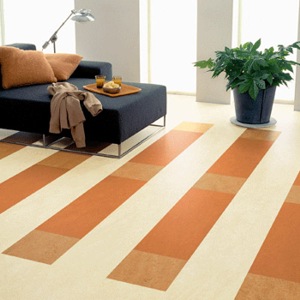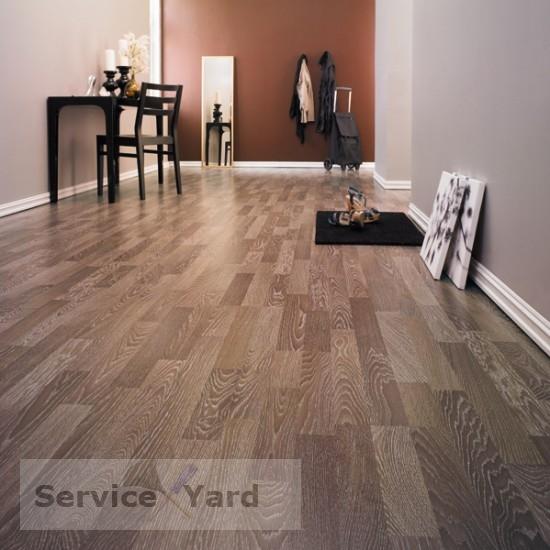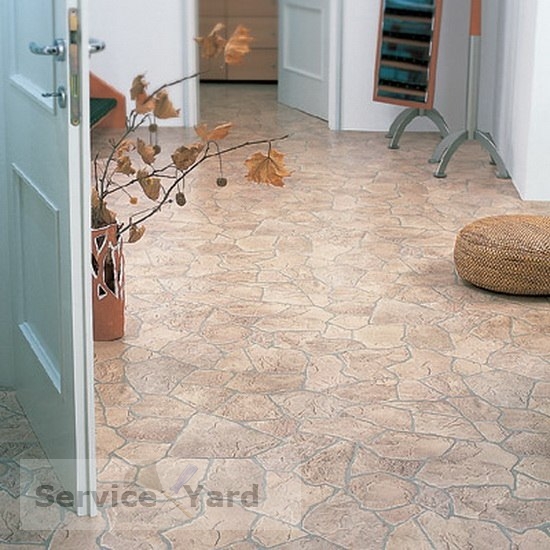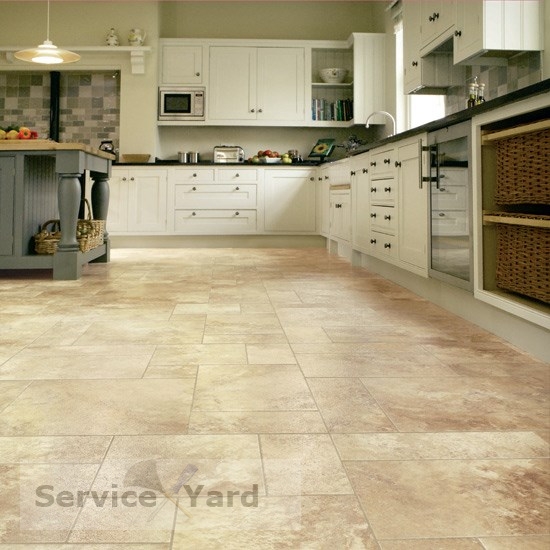Linoleum care at home

Linoleum is one of the most popular floor coverings, due to its advantages: strength, functionality, lightness and ease of cleaning. Caring for linoleum at home is a simple matter, but in order to maintain an attractive appearance of the flooring for a long time, it must be done regularly and correctly.
Important! With all its advantages, linoleum, like any other coating, has a number of disadvantages. Therefore, it must be remembered that the appearance and duration of operation directly depend on how carefully you will relate to the floor covering.
to contents ↑In order for the floor covering to have a presentable appearance for as long as possible, it is necessary to have at least a general understanding of the rules for caring for linoleum.
What is linoleum afraid of?
Linoleum is sensitive to temperature, chemical and mechanical influences. Consider the dangers that await coverage in everyday life:
- Hot water. If you regularly wash linoleum with hot water, then the upper coating layer will be erased, which will cause the appearance of ugly “bald spots” in the picture.
- Sunlight. Direct sunlight spoils the appearance of linoleum, turning a chic coating into a faded litter.
- Frost. Under the influence of cold, the coating is deformed and cracked, so never lay linoleum on the balcony and loggia.
- Water. PVC coatings do not like excess water. Therefore, do not put a wet mat on the surface at the entrance to the house or apartment to wipe your shoes, and when you care for linoleum, do not wet it strongly.
- Abrasive substances. A cleaning powder and a hard metal sponge scratch the surface of linoleum and leave ugly marks, so do not use these products when cleaning.
- Sharp objects. Heels, furniture legs, knives and forks, as well as other sharp objects can damage the surface of the PVC coating.
Important! If you install furniture on linoleum, then under the legs put plates of wood, plastic or metal, which are sold in any hardware store. This will protect the soft coating from mechanical stress.
- Bleach. The use of bleaches leads to loss of color and the appearance of spots, so if you use a cleaning product that contains chlorine, always dilute the concentrate with water. Better yet, use more gentle products to wash your linoleum.
How to care for linoleum?
 Household linoleum is mainly intended for residential premises. It costs much cheaper than other coatings, as it is made of materials with medium performance characteristics, and often does not have an upper protective layer.
Household linoleum is mainly intended for residential premises. It costs much cheaper than other coatings, as it is made of materials with medium performance characteristics, and often does not have an upper protective layer.
Therefore, in order to protect the PVC coating as much as possible from mechanical damage and extend the service life, you can carry out such care for linoleum at home.
We protect the floor
Self-treat the surface with polymer mastic or polish. With this treatment, a thin film is formed, which gives additional wear resistance.
The film will protect linoleum from many threats:
- Contact with liquid.
- Mechanical damage.
- Exposure to ultraviolet radiation.
- No traces of furniture wheels, as well as shoes.
Important! Protective films differ in color shades (glossy, matte), and in density (light, hard). Apply the protective agent on the coating in two layers and keep the material without load for at least 8-10 hours.
Scratch Prevention
To prevent cracking on the linoleum, lubricate the coating with linseed oil or linseed oil 1-2 times a month.
Important! Apply oil with a sponge, and then rub dry with a soft cloth.
Choosing the right tools
Select linoleum care products by type of coating, which is classified by type:
- Natural linoleum.
- Household linoleum coating.
- Commercial linoleum
- Non-profit linoleum.
to contents ↑Important! For each type among household chemicals from different manufacturers there are special series of products. When buying, read the labels carefully.
Linoleum Prevention
- To protect the PVC coating from mechanical damage, put a protective mat or grill at the entrance to the apartment to clean shoes from dirt and small stones that could scratch linoleum.
- Furniture in the apartment with wide legs or castors made of plastic is protected with felt stickers.
Important! Do not use rubber for stickers on the legs, as it will leave indelible spots on the surface.
- Protect the coating from contact with shoe polish, alcohol, and lipstick.
- Do not drop cigarettes or burning matches on a PVC coating.
- Do not drag heavy items along the linoleum as it may break. If you need to move objects, then lift them up and use the wheels or rug.
- To protect linoleum from direct sunlight, use curtains and blinds on the windows. This will avoid discoloration of the surface.
- Remove contaminants that appear on the surface immediately so that they do not have time to soak into the coating. Old stubborn stains are much more difficult to remove.
- Do not use chemical solvents, abrasives, or bleaches for cleaning.
Linoleum washing
 In the first 2-3 days after laying the PVC coating, you can not do wet cleaning, since linoleum should properly rest and “get used to” in the new environment. Do not forget to use our advice and treat the coating with a special protective compound to protect the surface from damage and protect from dirt.
In the first 2-3 days after laying the PVC coating, you can not do wet cleaning, since linoleum should properly rest and “get used to” in the new environment. Do not forget to use our advice and treat the coating with a special protective compound to protect the surface from damage and protect from dirt.
The rest of the rules are quite simple:
- Before daily wiping, linoleum must be cleaned with a vacuum cleaner or a broom, since in the opposite case, stains will be visible on the surface.
- It is advisable to wash linoleum with a soft cloth.
- You can wipe the floor simply with a damp cloth, and if necessary, wash it with water and a soap or powder solution.
to contents ↑Important! To clean the surface from severe contamination, use special linoleum care products. But apply them gently, in small amounts, and then they will clean the floor from old stains and stubborn dirt.
Folk remedies
 If you decide not to use household chemicals and provide quality care for linoleum at home using folk remedies, use the following tips:
If you decide not to use household chemicals and provide quality care for linoleum at home using folk remedies, use the following tips:
- Remove severe dirt on the surface with a soapy solution with vodka (200 g of vodka, 1 teaspoon of liquid detergent, add to a liter of water). After treatment, rinse the problem area with water and wipe the surface dry.
Important! This method is well suited for washing linoleum in light shades.
- Collect spilled grease on a surface with a paper towel and then treat with dishwashing detergent. If necessary, use turpentine, and then rinse the surface with water and wipe dry.
- Remove coffee stains and food coloring with gasoline or kerosene. Carry out the cleaning procedure carefully, as the solvents are not “friendly” with the coating.If after removing the stain there is still a trace, then treat it with lemon juice.
- Remove the fresh spot of brilliant green with two solutions: acetic acid with potassium permanganate and acetic acid with hydrogen peroxide. Proceed as follows:
- Moisten a cotton swab in the first solution and wipe the stain.
- After a few minutes, rinse the area with plain water.
- Apply a second solution - the stain will discolor and disappear.
- Repeat the procedure as necessary.
- Remove the green stain with hydrogen peroxide and camphor alcohol. Dampen the swab in the product and wipe the stain. After treatment, wash linoleum with warm, soapy water and wipe dry.
How to restore shine to linoleum?
- To “rejuvenate” obsolete linoleum, you can rinse it with milk mixed with water in a 1: 1 ratio.
- To make the PVC coating shine after harvesting, use water where potatoes were cooked. First cool the hot solution, and then wash the surface with “potato” water.
to contents ↑Important! In order to keep the PVC coating howling, never use the following cleaning products:
- Soda and other alkalis.
- Abrasive products.
- Bleach and solvents.
- Aggressive floor disinfectants.
How to clean linoleum after repair?
After repair on the surface remain:
- Polyurethane foam.
- Cement mortar.
- Whitewash.
- Another construction waste.
Important! Therefore, in order not to encounter problems of cleaning linoleum from repair traces, we recommend immediately protecting the PVC coating with plastic wrap or old newspapers.
If forged dust and other construction “troubles” made their way under the protective layer, then proceed as follows:
- Carry out dry cleaning and collect all construction waste - it is advisable to do this not with a broom, but with a vacuum cleaner.
- Use a spatula to scrape the putty off the coating.
- Remove dried mounting foam with a well-sharpened knife. Carefully, taking care not to damage the coating, scrape off the foam. Put a wet rag on the problem area for 10-12 hours so that the foam dries. After processing, wipe the surface with a damp cloth.
- For complex stains, use “646” or “White Spirit”.
- Wash dust and white deposits with warm water. Change the rag and water more often.
- At the final stage, add a little vinegar (potassium permanganate) to the water tank. Wash the finish clean with a soft, soft cloth and prepared solution.
- After cleaning the PVC coating after repair, be sure to wipe it dry and treat it with a thin layer of linseed oil or drying oil. Polish the surface well to give linoleum a fresh look.
Linoleum repair
Care for linoleum is not only about cleaning it, because over time, blisters and crevices at the joints can form on the surface of the coating.
We offer some simple ways to get rid of problems:
- If linoleum is swollen, pierce the “bubble” and let the air out. After a puncture, “melt” a small hole with a hot iron: put a sheet of paper on the puncture and iron it with a heated iron.
- If the swollen linoleum was on glue, then pour glue under the surface with a syringe, and carefully press the coating to the floor with any heavy object.
- Restore glued seams using a thin strip of the same linoleum. Insert a strip into the seam and melt with a soldering iron.
Important! This tip is not suitable for all types of linoleum. To avoid the problem of crevices, consider laying the cover so that the seams are in inaccessible places for the legs (under the carpet, furniture, etc.).
- If the surface of linoleum is damaged (for example, by a hot kettle), then make a patch of linoleum suitable for the drawing. Suture the seams with colored mastic.
- To care for linoleum, use a special mastic consisting of turpentine and rosin in a 4: 1 ratio. In this mixture, you can add paint to the color of linoleum to give the coating a fresh color.
Stock footage
We hope that the tips and recommendations outlined in the article will help you to care for linoleum correctly, and the coating will justify its qualities - durability, gloss, strength.
- How to choose a vacuum cleaner taking into account the characteristics of the house and coatings?
- What to look for when choosing a water delivery
- How to quickly create comfort at home - tips for housewives
- How to choose the perfect TV - useful tips
- What to look for when choosing blinds
- What should be running shoes?
- What useful things can you buy in a hardware store
- Iphone 11 pro max review
- Than iPhone is better than Android smartphones



